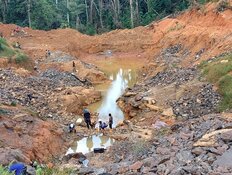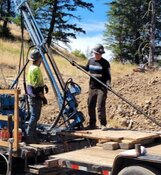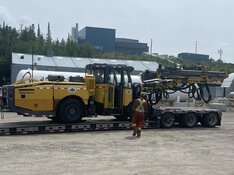The Gold Report: When you last spoke with The Gold Report in late May, gold was hitting its first bottom of 2012, just over $1,570/ounce (oz), after apparently breaking a multiyear uptrend around the end of March. Silver bottomed about a month later just under $26/oz. While both prices are higher as we speak, 2012 has been pretty much a sideways year. What are you predicting for 2013, in light of world economic and political developments over the past six months?
Alka Singh: Gold is trading over $1,700/oz again and silver is over $32/oz. I believe this trend will continue in the short-to-medium term with higher prices for both metals in 2013 as the global economic crisis will take at least a couple of years to be resolved. Gold has a unique characteristic, and the price of gold tends to increase both during an inflationary period as well as when there is deflation. I don't see gold or silver prices coming off from where they are right now.
TGR: Do you have any target figures in mind, or any specific catalysts that you think could cause a big breakout?
AS: Almost every country in Europe, as well as the U.S., is heavily debt-laden, and the countries are all trying to manage the debt crisis by printing more money. When that happens, gold prices will continue to increase. With Obama winning the election, the quantitative easing will continue, which will be very positive for gold in 2013. In terms of target prices, I think gold will move closer to $1,900/oz, if not $2,000/oz next year, and silver will be north of $35/oz.
TGR: Shouldn't silver have better leverage than gold? It has in the past.
AS: Basically, silver is poor man's gold, and silver prices have historically followed gold prices. However, silver has more leverage, as you mentioned, than gold. Historically the gold-silver price ratio has been about 25-27:1. In recent times, we have seen the gold-silver ratio around 50:1, so it's almost doubled. We don't expect gold prices to fall, so the only way to bring that ratio back to the historical average ratio is to have silver prices go competitively higher than gold prices.
TGR: The disconnect between metals prices and mining shares continues to frustrate investors looking for a turnaround. What do you think it will take to close this performance gap?
AS: If I had to pick a timeline, I would say in early 2013 we should start seeing the gap close. Gold equities have not kept up with the gold prices due to the volatility in the stock market. Investors are still very afraid of the stock market and the economy and don't know what to do. This fear is the reason why the equities have not performed as well as the metals.
"Silver has more leverage than gold."
The other big problem facing mining companies is that costs have been going up at a higher rate than metals prices, so profit margins have been squeezed. We saw operating costs increase for many of the large gold producers including Barrick Gold Corp. (ABX:TSX; ABX:NYSE), Kinross (K:TSX: KGC:NYSE), IAMGOLD Corp. (IMG:TSX; IAG:NYSE) and Newmont Mining Corp. (NEM:NYSE). We have also seen capital costs go up by 50–100% for the projects. That, together with the volatility in the stock market, has caused the equities to not keep up with metals prices.
For the gap to actually narrow, the companies have to make sure that the capital expenditure guidance they are giving to the market can actually be achieved. Until they are able to lower their costs and increase their profit margins, it will be very difficult for the gap to narrow, because it's easier for investors to buy gold bullion and exchange-traded funds and get the entire price appreciation, rather than buying the equities and facing all the operational and technical risks. I think that in 2013 that gap should start coming down, although I can't say with certainty that it will close. That's because the operational issues have been going on for over a year now.
TGR: It seems as if there has been negative leverage for the mining shares versus the positive leverage that people used to expect.
AS: That is absolutely correct. Until the companies and the managements of the companies start controlling their costs and start giving better guidance to the market, equities will underperform the commodities. Also, investors are now focusing more on dividends and cash flows than on growth, so management of the mining companies need to realize this and change their strategies accordingly.
TGR: Unlike in the past, when rising metals prices floated all stocks, it now seems that resource companies are increasingly being divided into what I would call the "haves," the "have-nots" and the "wannabes." Most investors are focusing on the haves, which are successful producers, and to a lesser extent on the wannabes that are smaller, but hoping to survive and grow. The vast majority, however, fall into the have-not category, that might hit on something or not survive. How is this influencing your investment choices at this point?
AS: The reason why investors are focusing on the companies that are haves is because they are usually large-cap companies that are already producers, which means that they are highly liquid and cash flow-positive. In a volatile market like this, investors do look for liquidity. When they get into a stock, they want to know that they are able to get out of it when they want to get out.
"Until companies start controlling their costs and start giving better guidance to the market, equities will underperform the commodities."
The have not category is one that performs very well when gold prices are increasing substantially and are expected to continue doing so, because the option value of their assets increases. During the times when gold prices are flat or the market volatility is high, we don't see these kinds of companies doing well, which is why you don't see investors buying companies in the have not category at this time.
The companies and equities that have been hit a lot are the ones that are in the wannabe category. These companies have good assets and good management teams, however, they are about three to five years away from being cash-flow positive. That means that they have assets that are either in the prefeasibility or the feasibility stage and it will take them at least two years to build a mine and be cash flow positive. They are suffering right now because when investors are afraid, they choose to invest in companies with positive cash flows, rather than companies that will be in production in two to three years. Wannabe companies are where investors should have the highest potential returns because they are now trading below their net asset values. As they are only about 12–36 months away from production, their stock prices should increase faster. Companies in this sector really have the most upside potential, if metals prices continue to increase and investors' risk appetite improves.
TGR: Maybe we can talk a little bit about specific companies that you're currently focusing on and what's going on with their exploration and development activities. Certainly, a lot of action is taking place in Mexico and Latin America. What's your view on what's going on there?
AS: A lot of companies are actually focusing on exploration in Mexico and Latin America because these countries are supposedly politically safe areas. With what we have seen happen in some countries in West Africa, investors are afraid of investing in much of Africa now other than, say, Ghana or perhaps Burkina Faso. We have seen a coup in Mali and some issues in Egypt and in West Africa as well as East Africa. Companies are actually focusing more on Latin and North America. Investors are ready to pay a good premium for companies with assets in Canada, U.S., Mexico, Chile, Brazil or Guyana because of the lower political risks.
"If investors are risk-averse, they should just stick with large-cap liquid names, like the large producers, which will probably pay dividends and have an upside when gold prices go up."
I want to talk about a few companies that we think are really solid. One of them is Atacama Pacific Gold Corp. (ATM:TSX.V). The Cerro Maricunga project in Chile has approximately 4.5 million ounces (Moz) . Currently, it is going through a preliminary economic assessment (PEA), the results of which are expected to be announced before the end of this year. I like the Cerro Maricunga gold project as it is all oxide associated ore, and the metallurgy for oxide is much easier and cheaper than for sulphide ore. I like the management team as well, and the insiders own 40% of the stock. That's my favorite name right now.
TGR: Would this be a low-grade, open-pit operation?
AS: Cerro Maricunga will be a low-grade, open-pit operation. The mineralization starts at surface and continues to over 500 meters in depth. Atacama will have a big open-pit operation at Cerro Maricunga.
I also like Volta Resources Inc. (VTR:TSX). The company has the Kiaka project in Burkina Faso. It has over 5 Moz of NI-43-101-compliant total gold resources. The company just put out its prefeasibility study and is now in the feasibility stage with those results to be announced in Q2/13. We like Kiaka because it's a big, low-grade, bulk-tonnage deposit. There are very few deposits in the world that have over 5 Moz, and this falls in that category. We like the management of Volta and think that Kiaka will become a mine over the next three to four years.
TGR: Most people have never heard of Burkina Faso. How politically stable is it?
AS: Burkina Faso is a democracy, very similar to Ghana. It did have some labor issues earlier this year, but those have all been resolved. IAMGOLD, SEMAFO Inc. (SMF:TSX; SMF:OMX), High River Gold Mines Ltd. (HRG:TSX) and Avocet Mining Plc (AVM:LSE) have operating gold mines in Burkina Faso. There are six producing gold mines in Burkina Faso right now. I think it's actually a politically safer jurisdiction than many of the other African countries.
TGR: What else do you like?
AS: In the silver space, I would like to mention Levon Resources Ltd. (LVN:TSX.V; L09:FSE; LVNVF:OTC). The stock has been beaten up a lot, just like every junior. Levon has over 455 Moz silver in politically safe Mexico and over $55 million in the bank. It has a deposit called Cordero, which is a Peñasquito look-alike deposit. With all the market volatility going on, the company has stopped drilling recently, but this is going to be another huge operation. Newmont owns about 11% of Levon. I really like Levon because of the silver exposure and the fact that it is one of the largest undeveloped silver projects in the world. There are not that many companies with good, undeveloped silver deposits in the world, and Levon is one of them.
TGR: Levon has been around for many, many years.
AS: That is correct.
TGR: Are there any other ones in Mexico or other places in South America that you'd like to talk about?
AS: I like Brazil Resources Inc. (BRI:TSX.V; BRIZF:OTCQX), which is obviously in Brazil. It just closed a deal about a month and a half ago with Luna Gold Corp. (LGC:TSX.V), where it bought Luna Gold's Cachoeira project. The project has about 667,000 oz (667 Koz) of gold and is expected to announce that it is getting into a PEA at Cachoeira. I think the company will be looking at other acquisitions as well. It's a good company with a management team that has a lot of experience in Latin America. The stock hasn't performed very well, just like the other juniors, but I think that it's a good company to hold.
TGR: Where is that trading these days?
AS: Brazil Resources is trading at $1.06/share and I have a 12-month target price of $1.45.
I would also like to mention Timmins Gold Corp. (TMM:TSX.V; TGD:NYSE.MKT). Timmins Gold has been ramping up production in Mexico. I don't cover it officially, but I really like the management team and the San Francisco gold mine in the Sonora State of Mexico that they operate. It's a nice, small operation, producing over 100 Koz gold at a low cost. I think that it has a lot of exploration upside as well and I like it a lot.
TGR: In general, what's your overall assessment of the metals situation these days? What do you think that investors ought to be doing to hopefully make some reasonable money in the coming year or at least protect their downside?
AS: If investors are risk-averse, I think that they should just stick with large-cap liquid names, like the large producers, which will probably pay dividends and have an upside when gold prices go up. Investors who have some risk appetite should choose among some of these smaller companies with good management teams and good assets in not very politically risky jurisdictions where projects could be in production over the next two to three years. Those will have the most upside over the next year.
TGR: That sounds both reasonably conservative and, hopefully, optimistic thinking. We'll have to see what happens with the metals markets and if they can drag these stocks along with them. Thanks for speaking with us today, Alka.
AS: I hope for the same. Thanks for having me.
Alka Singh started her career as a mining research associate with Wellington West Capital Markets in Toronto. Since then she has worked for Orion Securities and Merrill Lynch in Canada. She then moved to New York City to build the mining franchise for Rodman and Renshaw, where she covered 24 precious metals, base metals and uranium names. Singh has since started her own independent research firm, Mine2Capital, to provide unbiased research for clients. She holds a Bachelor of Science in geology and a Master of Business Administration in finance. She is a CFA charter holder.
Want to read more exclusive Gold Report interviews like this? Sign up for our free e-newsletter, and you'll learn when new articles have been published. To see a list of recent interviews with industry analysts and commentators, visit our Exclusive Interviews page.
DISCLOSURE:
1) Zig Lambo of The Gold Report conducted this interview. He personally and/or his family own shares of the following companies mentioned in this interview: None.
2) The following companies mentioned in the interview are sponsors of The Gold Report: Timmins Gold Corp. Streetwise Reports does not accept stock in exchange for services. Interviews are edited for clarity.
3) Alka Singh: I personally and/or my family own shares of the following companies mentioned in this interview: None. I personally and/or my family am paid by the following companies mentioned in this interview: None. I was not paid by Streetwise Reports for participating in this interview.










































